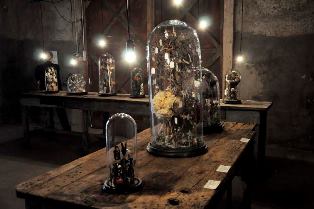
WTI Magazine #49 2014 December, 10
Author : Enrico De Iulis Translation by:
When one comes across a work by an unknown artist, rarely one wonders what is the his or her nationality, because this is irrelevant to know the purpose of the artistic language and, indeed, because is often challenging to receive messages and signals that are not part of our cultural heritage.
Probably all areas that can arouse synesthetic experiences such as cooking, music, nature, dance and dream are expressions in which language becomes universal, because they shared the everyday experience.
Pablo Mesa Capella, an Italian Spanish artist who has been living in Italy for years, works exactly on this last aspect: he exposes memories of past generations, re-emerging visions, feelings evoked by the combination of pale, ghoulish, close but untouchable objects.
They are untouchable because his works are protected by glass bells, in an exhibition that does not share and exchange the senses of smell or touch: separating the viewer from the artwork by making it distant even though close; but exalting it at the same time, because we are used to value and to accentuate the attention when we see something in a glass case.
It is a 360-degree view scenic project, a juxtaposition of objects assembled to evoke, exorcise or enhance a theme. Something close to the concept of natural death, implicit in the idea of the past, but that does not lose its beauty, indeed keeps it in a microsystem under the glass.
There are two possible directions of the approach to these works. The first is the finished vision of the bell, which is then dismantled to bring back the elements to their own experience: in this case the cultural heritage matters a lot, because the references to the Flemish suggestions, the Victorian era, the cabinets of wonders from seventeenth century, the Catholic shrines of the religious culture common to Italy and Spain, and the perpetually dream gaze contribute to cram in one shot many elements of the story of the Figurative Europe of the last five hundred years. The second, far more evocative and literary, is entrusted to the object's remembering: it is a story of its memory, its vision and its experience, many shapes that change and many figures walking around, changing perspective and relationship and color and message, all enclosed in fragile glass from which they cannot get out. Sentenced to expose themselves.
The result is amazing: it reduces us to Lilliputians that run these decadent and alienating microsystems, full of memories and annoyances, of poetic corners, two-dimensional humans in architectures created by other presences like animals, fetishes, marine exhibits, mineral waste, forgotten tools.
In parapsychology and even in the world of fantasy literature there is a power, a skill called "psychometrics": those who have this gift can trace the history of the objects just by touching them. Well, the art of Mesa Capella gives the gift of psychometry to the users of his works, creating the possibility of a common, alternative world, that of dreams and memories.



